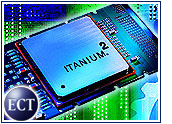
Intel is aiming new energy-efficient Itanium 2 processors at mainstream, high-density servers and high-performance applications with two lower-cost Itanium designs.
The Santa Clara, California-based chipmaker, which spurred optimism with its updated third-quarter revenue predictions last week, said the new chips, formally announced today, have already begun shipping in server systems from HP, IBM and others.
While technically close to the Itanium family of processors, the two new chips — a 1-GHz processor code-named Deerfield and a 1.4-GHz processor from the Madison line — have lower clock speeds and cache sizes to facilitate their use in rack-mounted or blade-type environments, Gartner research director Martin Reynolds told TechNewsWorld.
“Intel is making it easier to build Itanium devices,” Reynolds said. “They’re making Itanium more accessible.”
Low Voltage, Small Size
Reynolds said the 1-GHz Itanium 2 processor, which he called the more important of the two new chips, is a departure from Itanium’s history as the processing unit designed specifically for large servers.
“The Itanium servers used to be really big,” he said. “It was a big part to manage, it generated lots of heat, and it was expensive.” The new processors, because they have lower power requirements and are architecturally simpler, will help keep server costs and sizes down. Reynolds noted that servers based on the new Itanium 2 are ideal for blade servers or rack-mount environments and will be cheaper, smaller and easier to manage.
The low-voltage Itanium 2, with 1.5 MB of level three cache, draws less than half the power of previous Itanium 2 processors with a maximum power consumption of 62 watts, according to Intel.
The company, which is offering manufacturers a rack-optimized, dual-processor server platform for both new chips, said the number of Itanium-based server and workstation models likely will double this year to more than 40 two-way and four-way systems. Intel said its low-power Itanium 2 likely will be used in networks and engineering environments where power consumption and cost are key.
Intel spokesperson Scott McLaughlin, who said systems with the new processors are expected from HP, IBM, Dell and a host of smaller manufacturers, told TechNewsWorld that the platform will help smaller companies that do not have the time or resources to make their own to brand.
Performance Push
Reynolds said that while Itanium’s market growth has been slow, he expects it to “take off” as the market for the processor grows and Intel pushes its performance. Despite earlier market struggles, the Itanium processor family now is taking some of the top spots on benchmark rankings, according to Reynolds.
“Expect Intel to keep advancing it at a rate that’s faster than the competition,” he said. “They’re going to try and keep that performance gap going.”
The 1.4-GHz Itanium 2, which cuts cache on the chip in half to 1.5 MB and sells for less than other Madison processors from Intel, is intended for multiprocessor, high-performance applications. Reynolds said the smaller cache with higher clock speed makes the chip useful in constructing supercomputers that join many processors.
“It has the performance you need, but not the cache, which isn’t necessary in that setting,” Reynolds said. Intel said the 1.4-GHz Itanium 2 processor also will be useful in entry-level, front-end enterprise systems.
RISC to x86
With servers based on the new Itanium 2 processors expected from major manufacturers, Reynolds said the new processors represent a crossover from larger RISC servers to smaller x86 servers.
He said the new Itanium low-power movement is an attempt to take advantage of the trend toward many smaller servers as opposed to larger, more expensive machines.
“Generally, companies are looking for physically smaller servers so they can cram them in,” Reynolds said. “[The new Itanium processors are] helpful in that regard.”





















































